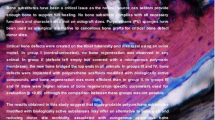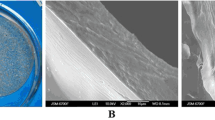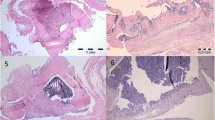Abstract
Freeze-dried dura mater allograft (FDDMA) was evaluated as a cost-effective collagenous barrier using an experimental animal model to determine its biocompatibility and 'cell-occlusivity' potential. The FDDMA was processed at the Civil Hospital Ahmedabad, in accordance with the guidelines provided by the South-Eastern Organ Procurement Foundation, U.S.A. Fifteen Charles Foster rats were selected for a study period of 9 weeks. The 1st set graft procedure was performed in an abdominal pouch and after 1 week bilateral mandibular defects were created. One defect was covered by the FDDMA barrier (2nd set graft procedure) and the other defect served as the control. The post operative autopsy and morphological and histological assessments were carried out at 2 and 4 weeks for the 1st set graft, and 3, 6 and 9 weeks for the 2nd set graft procedure. There was acceptance of the 2nd set graft in a pre-exposed animal and no significant inflammatory response. The processed FDDMA demonstrated optimal 'cell-occlusivity' potential for guided bone regeneration to take place in Charles Foster rats.
Similar content being viewed by others
References
Anderegg CR, Mellonig JT, Gher M, Gray J and Martin S (1991) Clinical evaluation of the use of decalcified freeze-dried bone allograft with guided tissue regeneration in the treatment of molar furcation invasions. J Periodontol 62: 264-268
Blumenthal N and Steinberg J (1990) The use of collagen membrane barriers in conjunction with combined demineralised bonecollagen gel implants in human infrabony defects. J Periodontol 61: 319-327
Blumenthal N (1992) The use of collagen membranes for guided tissue regeneration. Compend Contin Educ Dent XIII: 214
Busschop J and De Boever J (1983) Clinical and histological characteristics of lyophilised allogenic dura mater in periodontal bony defects in humans. J Clin Periodontol 10: 399-411
Chen CC, Wang HL, Smith F, Glickman GN, Yu Shyru and O'Neal RB (1995) Evaluation of a collagen membrane with or without bone grafts in treating periodontal intrabony defects. J Periodontol 66: 838-847
Dahlin C, Linde A, Gottlow J and Nyman S (1988) Healing of bone defects by guided tissue regeneration. Plast Reconstr Surg 81: 672-676
Dahlin C and Linde A (1993a) Tissue dynamics during new bone formation by osteopromotion membrane technique. Scand J Dent Res 1993 cited in Linde et al. J Periodontol 64: 1116-1128
Dahlin C, Sandberg E, Alberius P and Linde A (1993b) Restoration of long standing mandibular nonunion bone defects. An experimental study in rats using an osteopromotive membrane technique. Int J Oral Maxillofac Surg 1993 cited in Linde et al. J Periodontol 64: 1116-1128
Friedlaender GE, Strong DM and Sell KW (1984) Studies on the antigenecity of bone II donor specific anti-HLA antibodies in human recipient of freeze-dried allografts. J Bone Joint Surg 66: 107
Gottlow J (1993) Guided tissue regeneration using bioresorbable and non resorbable devices: Initial and long term results. J Periodontol 64: 1157-1165
Hyder PR and Dowell (1992) Freeze-dried, cross-linked, bovine type 1 collagen: Analysis of properties. J Periodontol 63: 182-186
Minabe M (1991) Acritical reviewof the biologic rationale of guided tissue regeneration. J Periodontol 62: 171
Nayot C and Beagrie GS (1978) An assessment of the biocompatibility of ‘lyodura’ in the oral mucosa of the hamster. J Periodontol 49: 181
Newman, Takei and Carranza (2003) Carranza's Clinical Periodontology, 9th edition, Saunders, U.S.A.
Quteish D, Singao S and Dolby AE (1991) Light and electron microscopic evaluation of biocompatibility resorption and penetration characteristics of human collagen graft material. J Clin Periodontol 18: 305-311
Schmitz JP and Hollinger JO (1979) The critical size defect as an experimental model for craniomandibulofacial nonunion. Clin Orthop 205: 299-308
South-Eastern Organ Procurement Foundation (1995) Guidelines and volumetary standards for excision, preparation, storage and distribution of human cadaver tissue for transplantation (obtained directly)
Tan AES (1993) New ideas and advancing technologies in periodontology: Surgical options with advancing technologies. Int Dent J 43: 567-577
Urist MR, O'Connor BT and Burwell RG (1994) Bone Grafts Derivatives and Substitutes, 1st edition, pp. 363-375, Butterworth-Heinemann, U.K.
World Workshop of Periodontology (1996) published by American Academy of Periodontology U.S.A.
Yukna RA (1992) Clinical human comparison of ePTFE membrane and freeze-dried dura mater allografts for lost periodontal support. I Mandibular molar class II furcations. J Periodontol 63: 431-442
Author information
Authors and Affiliations
Rights and permissions
About this article
Cite this article
Shah, A., Jathal, B. Evaluation of Freeze-Dried Dura Mater Allograft as a Collagen Based Barrier (an experimental animal study). Cell Tissue Banking 4, 133–139 (2003). https://doi.org/10.1023/B:CATB.0000007039.98845.bd
Issue Date:
DOI: https://doi.org/10.1023/B:CATB.0000007039.98845.bd




